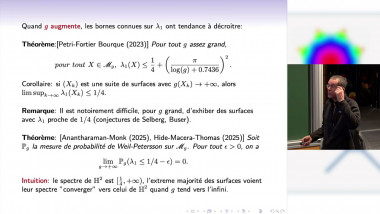
Problèmes ouverts et progrès récents en géométrie spectrale hyperbolique
By Frédéric Naud
By Jean Écalle
Appears in collection : Resurgence in Mathematics and Physics
Quite specific challenges attend the move from equational resurgence (i.e. resurgence in a singular variable –the main type in frequency and importance) to coequational resurgence (i.e. resurgence in a singular parameter –a close second, roughly dual to the first): complexity soars; two Bridge equations are required instead of one; the complex valued Stokes constants make way for discrete tessellation coefficients; the acting alien algebra remains isomorphic to an algebra of ordinary differential operators, but these are now subject to isographic invariance (meaning that they annihilate some specific differential two-form); and lastly, the new resurgence coefficients possess the paradoxical property of autarchy, combining sectorial resurgence with global entireness. We shall attempt a comprehensive, up-to-date survey of the field, with emphasis on the rather unexpected and quite novel structures spawned by these two regimes of resurgence.
